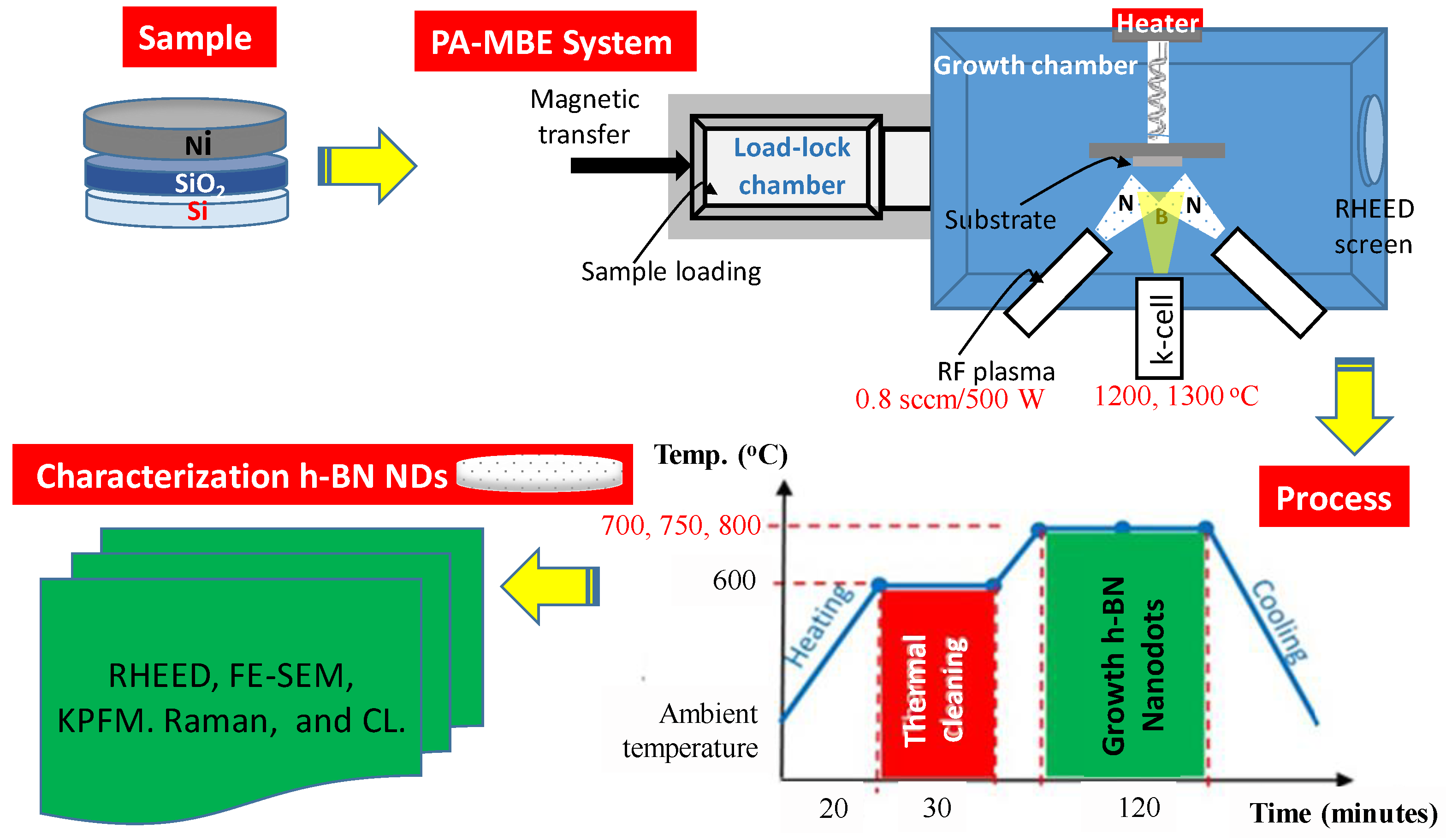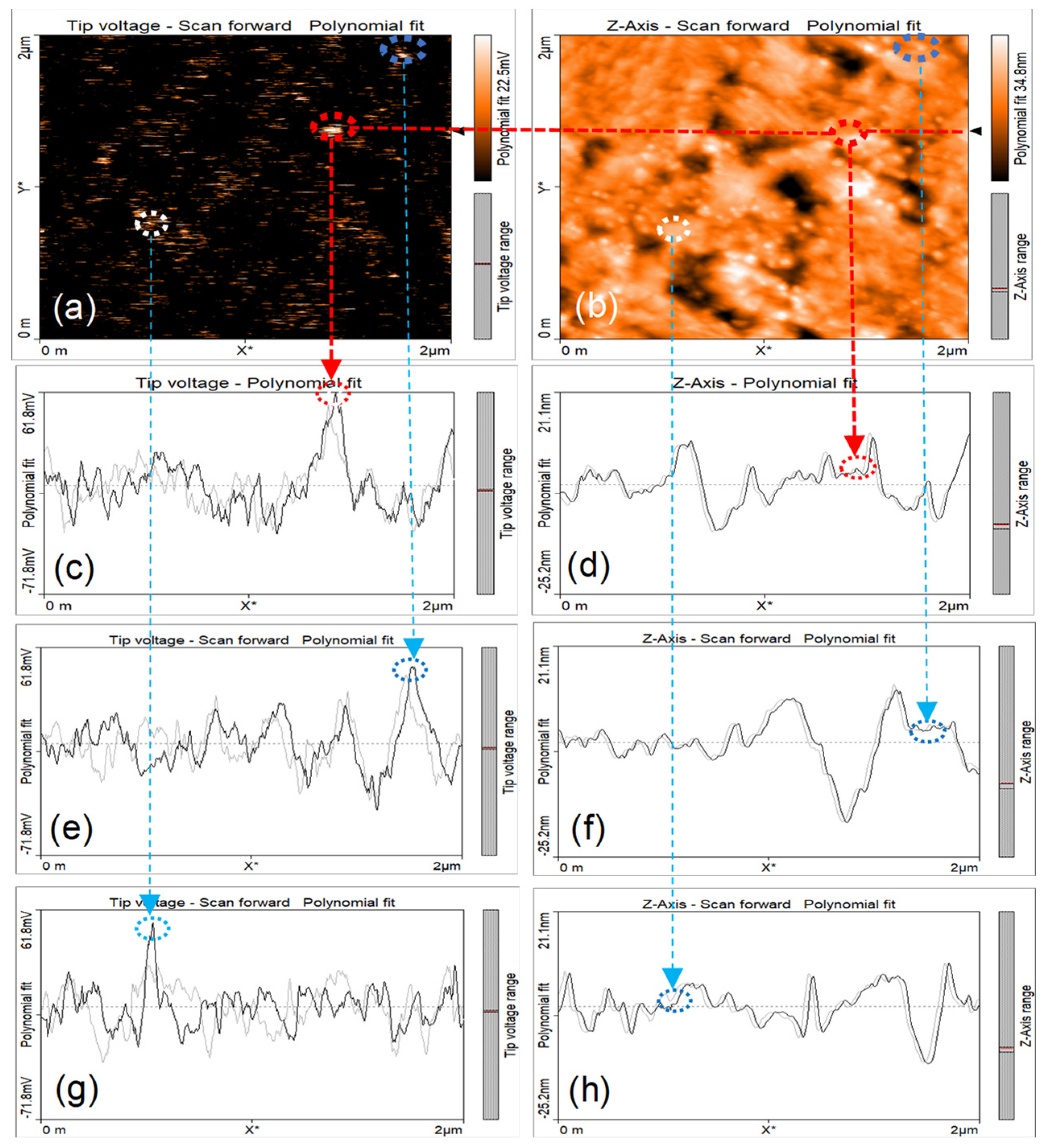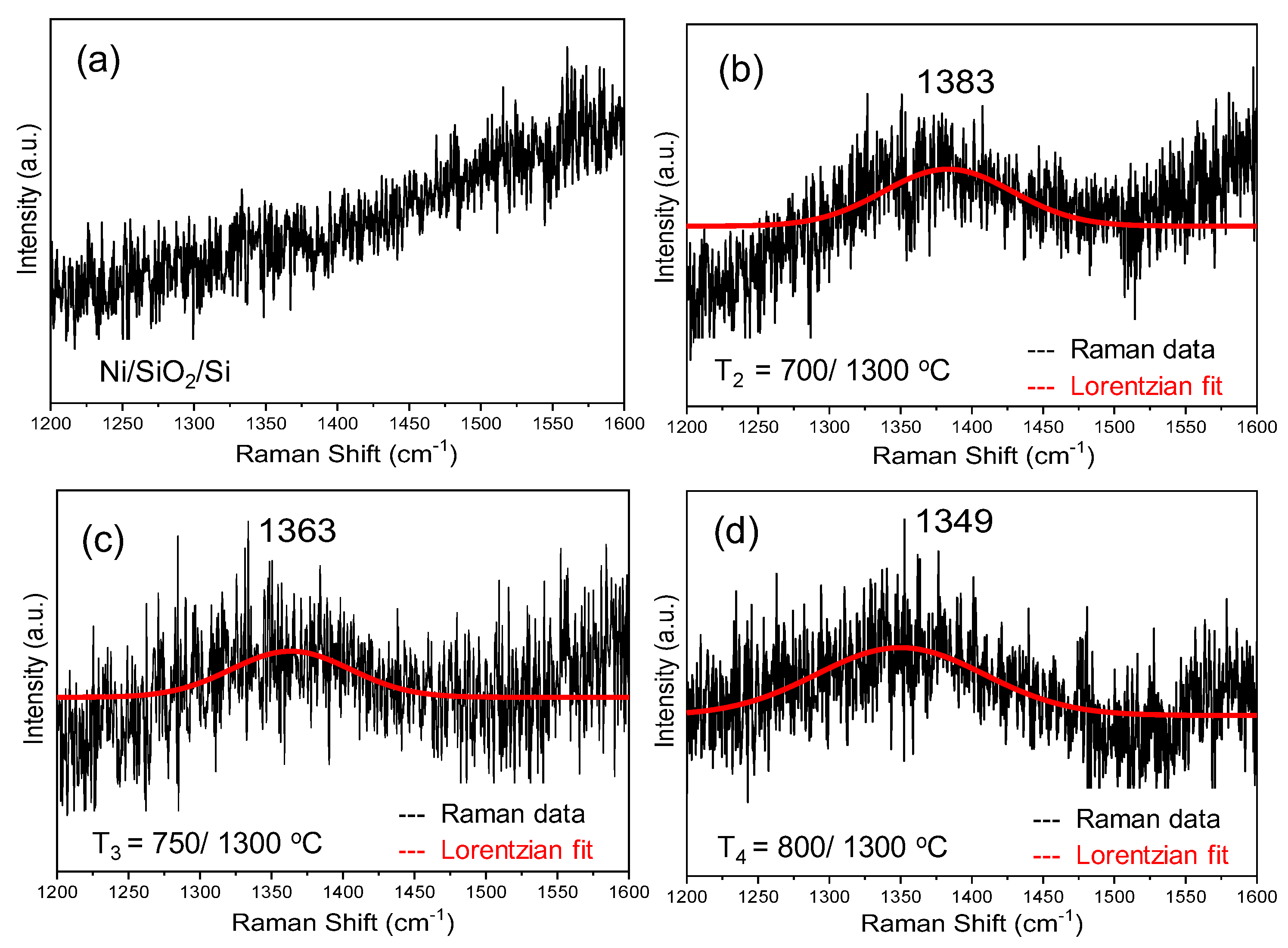The Growth of Hexagonal Boron Nitride Quantum Dots on Polycrystalline Nickel Films by Plasma-Assisted Molecular Beam Epitaxy
Abstract
:1. Introduction
2. Materials and Methods
2.1. Preparation of Substrate
2.2. The Growth of h-BN QDs
2.3. Characterizations of h-BN Quantum Dots
3. Results and Discussion
3.1. Reflection High-Energy Electron Diffraction
3.2. Field Emission-Scanning Electron Microscopy
3.3. Atomic and Kevin Probe Force Microscopy
3.4. Raman Analysis
3.5. Cathodoluminescence Analysis
4. Conclusions
Author Contributions
Funding
Institutional Review Board Statement
Informed Consent Statement
Data Availability Statement
Acknowledgments
Conflicts of Interest
References
- Cheng, T.S.; Davies, A.; Summerfield, A.; Cho, Y.; Cebula, I.; Hill, R.J.A.; Mellor, C.J.; Khlobystov, A.N.; Taniguchi, T.; Watanabe, K.; et al. High temperature MBE of graphene on sapphire and hexagonal boron nitride flakes on sapphire. J. Vac. Sci. Technol. B 2016, 34, 02L101. [Google Scholar] [CrossRef] [Green Version]
- Lee., S.H.; Jeong, H.; Okello, O.F.N.; Xiao, S.; Moon, S.; Kim, D.Y.; Kim, G.-Y.; Lo, J.-I.; Peng, Y.-C.; Cheng, B.-M.; et al. Improvements in structural and optical properties of wafer-scale hexagonal boron nitride film by post-growth annealing. Sci. Rep. 2019, 9, 10590. [Google Scholar] [CrossRef] [PubMed] [Green Version]
- Wofford, J.M.; Nakhaie, S.; Krause, T.; Liu, X.; Ramsteiner, M.; Hanke, M.; Riechert, H.; Lopes, J.M.J. A hybrid MBE-based growth method for large-area synthesis of stacked hexagonal boron nitride/graphene heterostructures. Sci. Rep. 2017, 7, 43644. [Google Scholar] [CrossRef] [Green Version]
- Ahmed, K.; Dahal, R.; Weltz, A.; Danon, J.J.Q.; Lu, Y.; Bhat, I.B. Effects of sapphire nitridation and growth temperature on the epitaxial growth of hexagonal boron nitride on sapphire. Mater. Res. Express 2017, 4, 015007. [Google Scholar] [CrossRef] [Green Version]
- Watanabe, K.; Taniguchi, T.; Kanda, H. Direct-bandgap properties and evidence for ultraviolet lasing of hexagonal boron nitride single crystal. Nat. Mater. 2004, 3, 404–409. [Google Scholar] [CrossRef]
- Chugh, D.; Wong-Leung, J.; Li, J.; Lysevych, M. Flow modulation epitaxy of hexagonal boron nitride. 2D Mater. 2018, 5, 045018. [Google Scholar] [CrossRef]
- Wang, H.; Zhang, X.; Liu, H.; Yin, Z.; Meng, J.; Xia, J.; Meng, X.M.; Wu, J.; You, J. Synthesis of large-sized single-crystal hexagonal boron nitride domains on nickel foils by ion beam sputtering deposition. Adv. Mater. 2015, 27, 8109–8115. [Google Scholar] [CrossRef]
- Siegel, G.; Gryzbowcki, G.; Hilton, A.; Muratore, C.; Snure, M. Growth of multi-layer hbn on Ni (111) substrates via MOCVD. Crystals 2019, 9, 339. [Google Scholar] [CrossRef] [Green Version]
- Nakhaie, S.; Heilmann, M.; Krause, T.; Hanke, M.; Lopes, J.M.J. Nucleation and growth of atomically thin hexagonal boron nitride on Ni/MgO (111) by molecular beam epitaxy. J. Appl. Phys. 2019, 125, 115301. [Google Scholar] [CrossRef]
- Tonkikh, A.A.; Voloshina, E.N.; Werner, P.; Blumtritt, H.; Senkovskiy, B. Structural and electronic properties of epitaxial multilayer h -BN on Ni (111) for spintronics applications. Sci. Rep. 2016, 6, 23547. [Google Scholar] [CrossRef] [Green Version]
- Khanaki, A.; Xu, Z.; Tian, H.; Zheng, R.; Zuo, Z.; Zheng, J. Self-assembled cubic boron nitride nanodots. Sci. Rep. 2017, 7, 4087. [Google Scholar] [CrossRef] [Green Version]
- Tsai, C.L.; Kobayashi, Y.; Akasaka, T.; Kasu, M. Molecular beam epitaxial growth of hexagonal boron nitride on Ni (111) substrate. J. Cryst. Growth 2019, 311, 3054–3057. [Google Scholar] [CrossRef]
- Cui, Z.; He, Y.; Tian, H.; Khanaki, A.; Xu, L.; Shi, W.; Liu, J. Study of direct tunneling and dielectric breakdown in molecular beam epitaxial hexagonal boron nitride monolayers using metal–insulator–metal devices. ACS Appl. Electron. Mater. 2020, 2, 747–755. [Google Scholar] [CrossRef]
- Nakhaie, S.; Wofford, J.M.; Schumann, T.; Jahn, U.; Ramsteiner, M.; Hanke, M.; Lopes, J.M.J.; Riechert, H. Synthesis of atomically thin hexagonal boron nitride films on nickel foils by molecular beam epitaxy. Appl. Phys. Lett. 2015, 106, 213108. [Google Scholar] [CrossRef] [Green Version]
- Cheng, T.S.; Summerfield, A.; Mellor, C.J.; Khlobystov, A.N.; Eaves, L.; Foxon, C.T.; Beton, P.H.; Novikov, S.V. High-temperature molecular beam epitaxy of hexagonal boron nitride with high active nitrogen fluxes. Materials 2018, 11, 1119. [Google Scholar] [CrossRef] [Green Version]
- Wrigley, J.; Bradford, J.; James, T.; Cheng, T.S.; Thomas, J.; Mellor, C.J.; Khlobystov, A.N.; Eaves, L.; Foxon, C.T.; Novikov, S.V.; et al. Epitaxy of boron nitride monolayers for graphene-based lateral heterostructures. 2D Mater. 2021, 8, 034001. [Google Scholar] [CrossRef]
- Xu, Z.; Khanaki, A.; Tian, H.; Zheng, R.; Suja, M.; Zheng, J.G.; Liu, J. Direct growth of hexagonal boron nitride/graphene heterostructures on cobalt foil substrates by plasma-assisted molecular beam epitaxy. Appl. Phys. Lett. 2016, 109, 043110. [Google Scholar] [CrossRef]
- Xu, Z.; Tian, H.; Khanaki, A.; Zheng, R.; Suja, M.; Liu, J. Large-area growth of multi- layer hexagonal boron nitride on polished cobalt foils by plasma-assisted molecular beam epitaxy. Sci. Rep. 2017, 7, 43100. [Google Scholar] [CrossRef]
- Vuong, T.Q.P.; Cassabois, G.; Valvin, P.; Rousseau, E.; Summerfield, A.; Mellor, C.J.; Cho, Y.; Cheng, T.S.; Albar, J.D.; Eaves, L.; et al. Deep ultraviolet emission in hexagonal boron nitride grown by high-temperature molecular beam epitaxy. 2D Mater. 2017, 4, 021023. [Google Scholar] [CrossRef]
- Page, R.; Casamento, J.; Cho, Y.; Rouvimov, S.; Xing, H.G.; Jena, D. Rotationally aligned hexagonal boron nitride on sapphire by high-temperature molecular beam epitaxy. Phys. Rev. Mater. 2019, 3, 064001. [Google Scholar] [CrossRef] [Green Version]
- Bhowmick, S.; Singh, A.K.; Yakobson, B.I. Quantum dots and nanoroads of graphene embedded in hexagonal boron nitride. J. Phys. Chem. C 2011, 115, 9889–9893. [Google Scholar] [CrossRef]
- Srivastava, M.; Singh, J.; Kuila, T.; Layek, R.K.; Kim, N.H.; Lee, J.H. Recent advances in graphene and its metal-oxide hybrid nanostructures for lithium-ion batteries. Nanoscale 2015, 7, 4820–4868. [Google Scholar] [CrossRef] [PubMed]
- Zhang, Q.; Nie, C.; Chang, C.; Guo, C.; Jin, X.; Qin, Y.; Li, F.; Li, Q. Highly luminescent red emitting CdZnSe/ZnSe quantum dots synthesis and application for quantum dot light emitting diodes. Opt. Mater. Express 2017, 7, 3875. [Google Scholar] [CrossRef]
- Fan, Z.; Li, S.; Yuan, F.; Fan, L. Fluorescent graphene quantum dots for biosensing and bioimaging. RSC Adv. 2015, 5, 19773–19789. [Google Scholar] [CrossRef]
- Shammas, J.; Sun, T.; Koeck, F.A.M.; Rezykyan, A.; Nemanich, R.J. In situ photoelectron spectroscopic characterization of c-BN films deposited via plasma enhanced chemical vapor deposition employing fluorine chemistry. Diam. Relat. Mater. 2015, 56, 13–22. [Google Scholar] [CrossRef]
- Susanto, I.; Kan, K.-Y.; Yu, I.-S. Temperature effects for GaN films grown on 4H-SiC substrate with 4° miscutting orientation by plasma-assisted molecular beam epitaxy. J. Alloys Compd. 2017, 723, 21–29. [Google Scholar] [CrossRef]
- Hasegawa, S. Reflection High-Energy Electron Diffraction. In Characterization of Materials; John Wiley & Sons: Hoboken, NJ, USA, 2012; pp. 1928–1931. [Google Scholar]
- Laleyan, D.A.; Mengle, K.; Zhao, S.; Wang, Y.; Kioupakis, E.; Mi, Z. Effect of growth temperature on the structural and optical properties of few-layer hexagonal boron nitride by molecular beam epitaxy. Opt. Express 2018, 26, 23031. [Google Scholar] [CrossRef]
- Xie, B.; Liu, H.; Hu, R.; Wang, C.; Hao, J.; Wang, K.; Luo, X. Targeting cooling for quantum dots in white QDs-LEDs by hexagonal boron nitride platelets with electrostatic bonding. Adv. Funct. Mater. 2018, 28, 1081407. [Google Scholar] [CrossRef]
- Yamada, H.; Inotsume, S.; Kumagai, N.; Yamada, T.; Shimizu, M. Chemical vapor deposition growth of BN thin films using B2H6 and NH3. Phys. Status Solidi B 2020, 257, 1900318. [Google Scholar] [CrossRef]
- Nistor, S.V.; Nistor, L.C.; Joita, A.C.; Vlaicu, A.M. Presence and distribution of impurity defects in crystalline cubic boron nitride. A spectroscopic study. Radiat. Meas. 2019, 123, 21–25. [Google Scholar] [CrossRef]






| Parameter | T2 (700 °C) | T3 (750 °C) | T4 (800 °C) | |||
|---|---|---|---|---|---|---|
| Ra | LCPD | Ra | LCPD | Ra | LCPD | |
| Average | 4.15 | 10.56 | 8.02 | 9.75 | 8.71 | 9.63 |
| Max. peak height | 20.72 | 61.82 | 29.41 | 59.19 | 47.01 | 68.13 |
| Max. peak depth | −25.23 | −64.89 | −38.63 | −55.21 | −58.04 | −62.85 |
Publisher’s Note: MDPI stays neutral with regard to jurisdictional claims in published maps and institutional affiliations. |
© 2022 by the authors. Licensee MDPI, Basel, Switzerland. This article is an open access article distributed under the terms and conditions of the Creative Commons Attribution (CC BY) license (https://creativecommons.org/licenses/by/4.0/).
Share and Cite
Nurzal, N.; Huang, W.-C.; Liu, C.-Y.; Chen, S.-H.; Yu, I.-S. The Growth of Hexagonal Boron Nitride Quantum Dots on Polycrystalline Nickel Films by Plasma-Assisted Molecular Beam Epitaxy. Crystals 2022, 12, 347. https://doi.org/10.3390/cryst12030347
Nurzal N, Huang W-C, Liu C-Y, Chen S-H, Yu I-S. The Growth of Hexagonal Boron Nitride Quantum Dots on Polycrystalline Nickel Films by Plasma-Assisted Molecular Beam Epitaxy. Crystals. 2022; 12(3):347. https://doi.org/10.3390/cryst12030347
Chicago/Turabian StyleNurzal, Nurzal, Wei-Cyuan Huang, Cheng-Yu Liu, Su-Hua Chen, and Ing-Song Yu. 2022. "The Growth of Hexagonal Boron Nitride Quantum Dots on Polycrystalline Nickel Films by Plasma-Assisted Molecular Beam Epitaxy" Crystals 12, no. 3: 347. https://doi.org/10.3390/cryst12030347
APA StyleNurzal, N., Huang, W.-C., Liu, C.-Y., Chen, S.-H., & Yu, I.-S. (2022). The Growth of Hexagonal Boron Nitride Quantum Dots on Polycrystalline Nickel Films by Plasma-Assisted Molecular Beam Epitaxy. Crystals, 12(3), 347. https://doi.org/10.3390/cryst12030347







